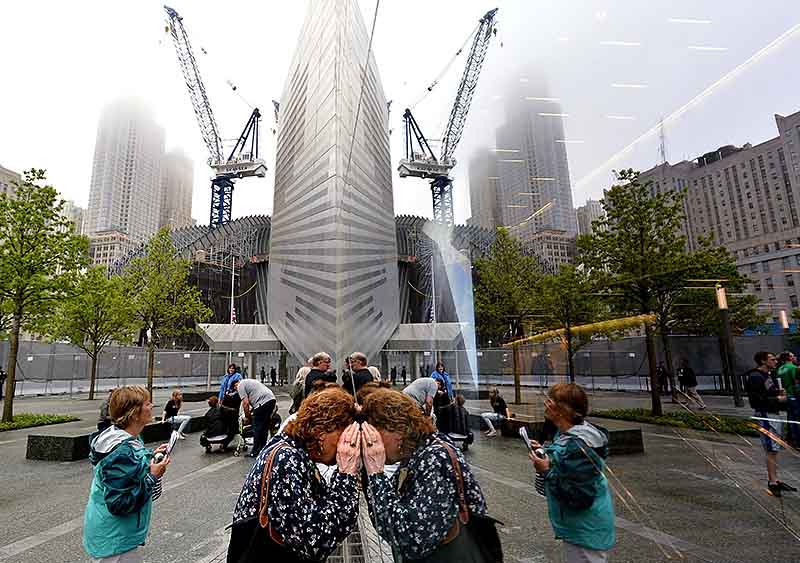By Francis X. Donnelly The Detroit News

A woman tries to look through the windows of the National September 11 Memorial Museum. (Justin Lane/Getty Images)
Former Flint resident David Beamer descended into an underground museum Thursday that was part grave and part history lesson.
Among mangled metal and steel salvaged from the World Trade Center were thousands of exhibits, including a wristwatch that belonged to his late son. The Rolex bore the date it stopped working, the day when all time stopped, the date that became synonymous with a national nightmare.
The National September 11 Memorial Museum in New York, dedicated by President Barack Obama in an emotional service, bills itself as nothing less than the repository of every story from that traumatic day. It opens to the public Wednesday.
Two dozen of the stories began in Michigan, told by former residents who died that day or local artists who contributed art about the calamity.
Take Beamer’s son, Todd, the Flight 93 passenger whose “let’s roll” exhortation rallied others to confront the plane’s hijackers before it crashed near Shanksville, Pa.
Beamer, who sits on the museum board, said the sight of his son’s watch and photo weren’t the only reasons the visit was so wrenching. It was the photos and mementos of nearly 3,000 other Todd Beamers.
“It’s tough, it’s tough,” he said. “All Americans were personally touched by this.”
He didn’t see all the death and destruction about him as the ending of something. He saw it as a rebirth. The lessons of that day can inform what the world does in the future, he said.
“It’s really needed,” he said about the museum. “For today and tomorrow and the years after.”
Beneath ground zero, the museum descends seven stories to the bedrock on which the towers were built. It describes what happened in New York, Washington and Shanksville through time lines and thousands of photos, videos and descriptions by witnesses. The victims also are heard, through their final phone calls to loved ones.
The subterranean lair holds 7,930 unidentified remains behind a wall with an inscription by Virgil: “No day shall erase you from the memory of time.”
Some of the exhibits are embedded in the national consciousness. They include a 17-foot crossbeam, resembling a cross, where rescue workers held Mass every day. And the last item removed from the wreckage, a 36-foot steel column that became a makeshift shrine, covered with inscriptions, fliers and mementos.
Other objects aren’t as well known. One was a thick girder bent like a pretzel by the plane that struck the north tower. Another was a 21-foot section of the building’s battered staircase, used by hundreds of people scurrying to safety.
Museum triggers emotions
A wall of the museum holds portraits of the 2,983 victims, while a room shows video of loved ones’ remembrances.
One of the victims is Alicia Titus, 28, a flight attendant whose plane struck the south tower.
Her father, John, a former college administrator activist has mixed feelings about the museum.
It’s important for people to remember what happened, he said from his home in Gregory, near Ann Arbor. For him, though, the memories come with a price.
“It puts you right back into a deep sense of grief and sadness and loss,” he said.
He and his wife, Bev, plan to visit the museum anyway. The grief is now part of who they are, he said.
They may visit during a dedication period open to families that began Thursday.
It all depends on the arrival of their future grandchild. Their son and daughter-in-law expect a baby any day.
Clarity through painting
Orange flames. Smoky ash. Shattered glass. Falling bodies.
The violent images swirl about the World Trade Center in seven paintings by Ann Arbor artist Margaret Parker. Her work is shown on the museum website and eventually may appear on a museum wall of tribute art.
Each of her paintings shows the towers as empty white space. They look like ghosts.
Parker recalled the utter confusion of September 11. She sought clarity by picking up a paintbrush.
“I wanted to stop time,” she said. “An artist can show you something important to remember.”
Documentary called unfair
Besides documenting what happened September 11, the museum also describes the events leading up to the terrorist attacks and how they continue to influence the world today.
Along those lines, Muslims in Michigan and elsewhere are upset about a museum documentary that describes the terrorist group responsible for the attacks.
They said The Rise of Al Qaeda, by using words like “jihad” and “Islamist,” unfairly links their faith to terrorism.
“At the end of the day, No faith condones wanton violence and terrorism,” said Dawud Walid, executive director of the Michigan branch of the Council on American-Islamic Relations.
He also criticized the museum for not seeking more input from Muslims in the planning of the exhibits. The museum’s interfaith advisory panel had a single Muslim, who resigned over the documentary.
The museum said it stands behind the film.
Museum opening a surprise
Jack Vander Baan wasn’t aware of Thursday’s dedication. He didn’t know about the museum at all.
Even if he had known, he wouldn’t be able to visit, he said. Handicapped and 86, he mostly stays near his home in Wayland, near Grand Rapids.
But that doesn’t stop him from thinking about the daughter he lost a dozen Septembers ago. Barbara Edwards, a mother of three, was a passenger on the plane that crashed into the Pentagon.
Vander Baan, a retired General Motors tool and die worker, said he was pleased to learn of the museum and its imminent opening.
“I think it’s wonderful.” he said.

